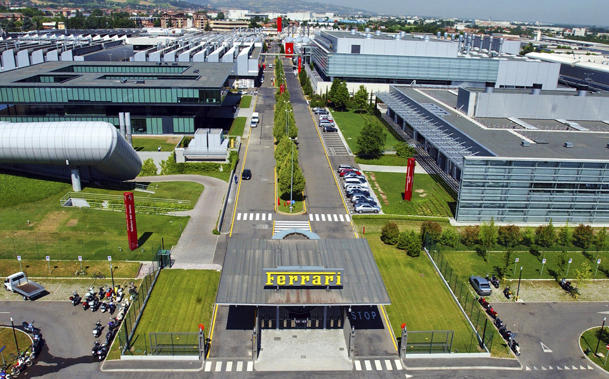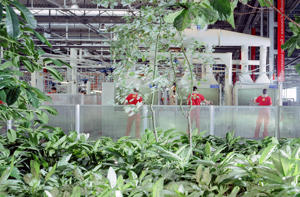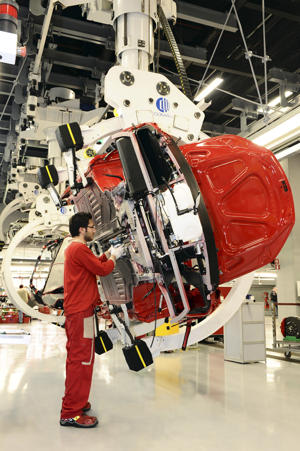
As an address, Via Abetone Inferiore 4 in the northern Italian town of Maranello won't stir the soul like Paris' Champs-Elysee or London's King's Road -- unless you're an aficionado of the automobile. This is the home of Ferrari, manufacturer since 1947 of some of the planet's winningest racing machines and most stirring sports cars.
On a recent afternoon, I presented myself at the factory gates in the hopes of taking a peek inside. I felt like Charlie Bucket waiting to slip inside Willy Wonka's candy factory; Ferrari offers no public tours, and the golden ticket is a Ferrari vehicle serial number and lots of advance notice. (No on both.) Or a press credential and decent standing with the keepers of the Prancing Horse keys. (Check.)
"A tour of Ferrari is a treat only for some, typically our customers or the sponsors of our Formula One team," says Stefano Lai, Ferrari's lanky bilingual communications director, handing me a visitor's pass. "What you'll see inside speaks to our attitude not just toward our cars but also our people."

Over the next two hours, I and six stoked California Ferraristi are given a leisurely look at the sprawling 36-acre complex, including prolonged stops at the 160,000-square-foot machine shop where Ferrari 8 and 12 cylinder engines start life, the cozy engine assembly area where workers patiently assemble each power plant by hand, the sprawling assembly line, and the Gestione Sportiva area, where, if you visit during the right time, you'll see Ferrari Formula One cars being cobbled together. Off limits are offices and test facilities where future cars are in development.
In the marque's darker days of the '70s and '80s, its antique manufacturing made Ferraris synonymous with both arresting beauty and mediocre quality. (In 1985, I sat in a months-old 512 BBi with a glowing light alerting the engine cover was open, when it wasn't. The owner simply shrugged, saying it was that way from new.)
Today, Ferrari looks like a manufacturing leader. The factory's gleaming glass and steel structures are the work of celebrated architects. Ferrari planted 25,000 trees and 200 species of plants around the factory to cut its carbon emissions. There's also an array of solar panels, a power station burning natural gas and a fleet of red bikes that some 2,500 red-suited employees use to get around. It's part of a modernization by Ferrari chairman Luca di Montezemolo, who calls the ethos Formula Uomo, "uomo" meaning man in Italian.

No matter which facility we drop in, no one seems to be in a rush or yelling. Often the loudest thing heard is the dull squeak of rubber wheels against a painted floor. Carts containing parts for each car roll from station to station. An almost Teutonic sense of order reigns, and nowhere more so than in the assembly line facility.
Entering this cavernous area, Michael Yancey gasps. "So, this is where it all happens," he whispers as the body shell of a California loops over our heads on the way to becoming a quarter-million-dollar showroom queen.
Yancey is new to Ferrari after decades in Porsches, and impressing folks like him is savvy marketing, considering many Ferrari owners arrive through word of mouth. Yancey made the switch after years of hectoring from his Ferrari fanatic brother, David. The San Francisco-based commercial real estate investor recently took delivery of a black California.
"Being here, I get the sense that a lot of care goes into making these cars, that the notion of them being hand made really is true," says Yancey, who then laughs. "They're expensive machines, twice a Porsche. But maybe now I see I'm not over-paying as much as I thought I was."
In this facility, where a Ferrari becomes a Ferrari, you witness an impressive ballet between man and machine. Anything heavy or repetitive is outsourced to a robot of some kind, but any job requiring judgement and a deft touch are left to workers.
In the former camp are jobs such as ferrying the increasingly complete automobiles from station to station, some 50 in all, where craftsmen wait to rig wiring, install seats and mate gearboxes to transmissions. The most impressive mechanical assist comes from the jig each body is attached to: it swivels on command to place the shell at just the right height and angle depending on the worker's size.
Similarly, the most dazzling piece of hand assembly happens on the dashboards, where unblemished hides and flawless carbon fiber are fitted into the area that each Ferrari owner will come to know well. All told, some 30 cars leave the factory daily, around 7,000 per year. (A typical auto factory can build that many cars in two weeks.)
The tour concludes with a visit to Gestione Sportiva. While there are no 2012 F1 cars on display here today, there are a few dozen older F1 models all in Ferrari's trademark Rosso Corsa red. All are owned by customers, but kept by Ferrari and shipped to tracks for driving events. The Corse Clienti program leaves Yancey's head spinning.

"Just incredible, nearly $2 million to own one of these old F1 cars and about a million a year to fly it around to whatever tracks you want, complete with your own Ferrari pit crew," he says. He later asks the tour guide how much the insurance is on a building with some $40 million worth of cars. Her blunt answer: "High."
That's pretty much how the tour group feels when the tour bus drops us back at the reception area, next to the gift shop. For a moment, we're all a bit deflated - it's a bit like heading into the stands after visiting the locker room. But there is a consolation prize that will be handed out each time a Ferrari rips down a street near us. We may not know where that car will wind up, but it's extremely satisfying to know where it started.
Credits to
Motoramic - Yahoo!







